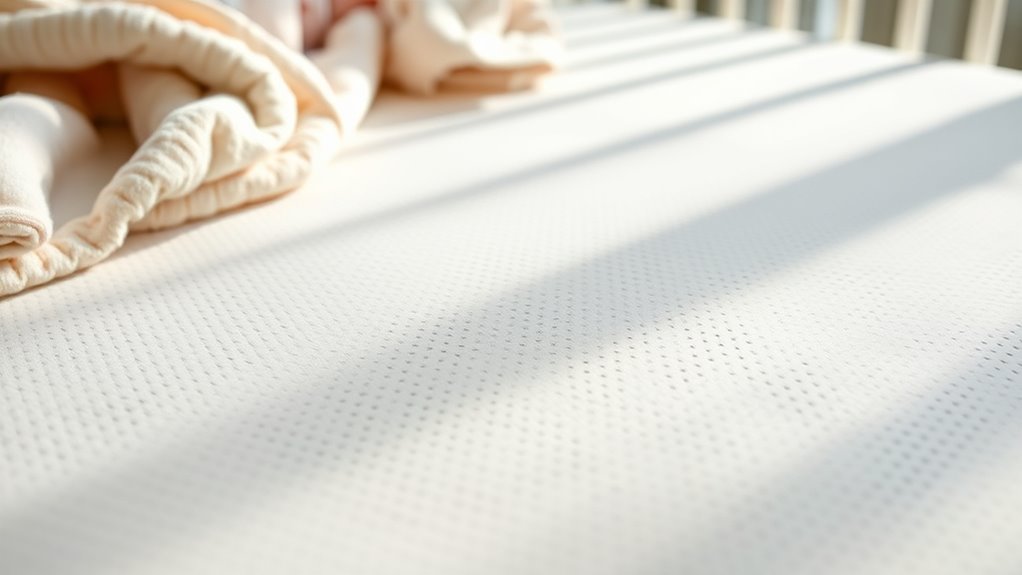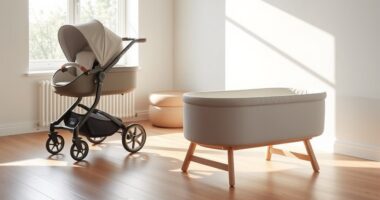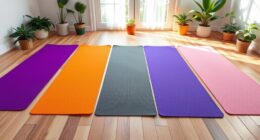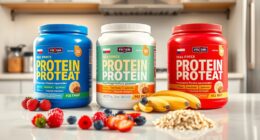To guarantee your baby’s mattress is truly breathable, look for one with natural, airflow-friendly materials like organic cotton, wool, or latex. Check for features such as ventilation channels, perforations, or breathable covers that promote airflow and regulate temperature. Avoid dense foam or synthetic materials that trap heat and moisture. A breathable mattress helps reduce overheating, minimize suffocation risks, and create a safer sleep environment. Keep exploring to learn the key factors that make a mattress genuinely safe and breathable.
Key Takeaways
- Breathable baby mattresses promote airflow, helping regulate temperature and reducing overheating risks.
- Natural materials like organic cotton, wool, or latex enhance breathability compared to synthetic foams.
- Ventilation features such as air channels and perforations significantly improve airflow and comfort.
- Chemical-free, non-toxic materials ensure safety and prevent exposure to harmful chemicals like fire retardants.
- Maintaining optimal room conditions and using washable covers support overall breathability and a healthy sleep environment.
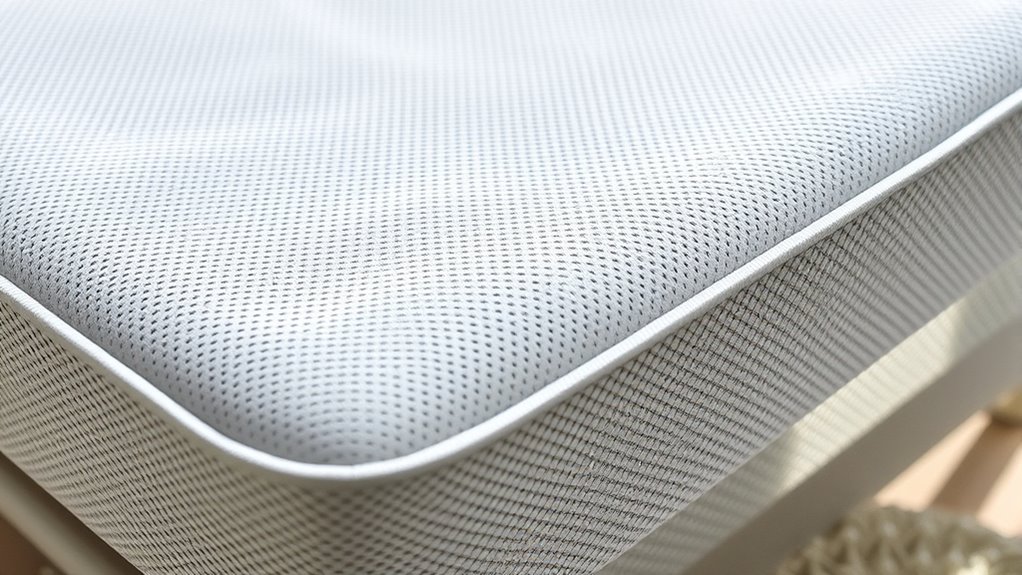
Choosing the right mattress for your baby is crucial for their safety and comfort, especially when it comes to breathability. A truly breathable mattress helps regulate temperature, reduce the risk of overheating, and allows air to circulate freely around your baby’s face and body. But beyond comfort, material safety is a critical consideration. You want to confirm that the materials used are non-toxic, free from harmful chemicals, and meet safety standards. Many manufacturers now prioritize organic and natural fibers, which can provide peace of mind regarding chemical exposure and off-gassing. When considering a mattress, check for labels indicating that it’s free from fire retardants, PVC, phthalates, and other potentially hazardous substances. A safe, breathable mattress contributes considerably to establishing a healthy sleep environment for your baby, minimizing risks associated with suffocation or Sudden Infant Death Syndrome (SIDS).
Understanding what makes a mattress breathable starts with knowing the materials used. Natural materials like organic cotton, wool, or latex tend to offer better airflow, helping to wick away moisture and prevent heat buildup. Synthetic foams, on the other hand, can trap heat and moisture, creating a less than ideal sleep environment. Look for mattresses with breathable covers or those designed with ventilation features, such as air channels or perforations, that promote airflow. These design elements help keep your baby cool and comfortable throughout the night, reducing fussiness caused by overheating. Additionally, the firmness of the mattress is important; a firm, supportive surface not only enhances safety but also encourages proper spinal development. When combined with breathable materials, a firm mattress becomes a key factor in creating a sleep environment that’s both safe and conducive to restful sleep. Furthermore, choosing a mattress with ventilation features can significantly improve overall airflow and comfort. Proper material safety is equally vital, as it directly impacts your baby’s health and well-being. Using breathable fabrics in the construction of the mattress can also enhance airflow and moisture-wicking properties. Maintaining optimal room temperature and humidity levels also plays a crucial role in supporting your baby’s comfort and safety. Additionally, ensuring that the mattress has adequate airflow channels can help prevent heat retention and promote continuous ventilation.
You should also consider the ease of cleaning and maintenance, as a clean sleep environment is essential for your baby’s health. Breathable mattresses often feature removable, washable covers that allow you to keep the sleep space fresh and free of allergens. Regular cleaning helps prevent dust mites, mold, and bacteria, which can compromise material safety and your baby’s overall health. Remember, a well-ventilated sleep environment isn’t just about the mattress; it’s about the entire crib setup, room temperature, and humidity levels. Ensuring these elements work together will promote safer, more comfortable sleep for your little one. Ultimately, investing in a breathable, safe mattress not only safeguards your baby’s health but also helps foster healthy sleep habits that can last a lifetime.
Frequently Asked Questions
How Can I Test if My Baby’s Mattress Is Truly Breathable?
To verify if your baby’s mattress meets breathability standards, start with mattress testing methods like airflow tests or moisture-wicking assessments. Look for labels that specify compliance with safety standards. You can also gently press on the mattress and observe how quickly air flows through it. These steps help make certain the mattress promotes good airflow, reducing overheating and suffocation risks, giving you peace of mind about your baby’s sleep safety.
Are There Any Safety Risks With Highly Breathable Mattresses?
While highly breathable mattresses offer better airflow, they can pose safety risks if not designed properly. You should watch out for potential fire hazards, as some materials might be more flammable. Additionally, if the mattress isn’t kept clean and dry, mold growth could develop, which is harmful to your baby’s health. Always choose certified, safety-tested mattresses and follow care instructions to minimize these risks.
Do Breathable Mattresses Prevent SIDS Better Than Traditional Ones?
Breathable mattresses can help improve sleep safety by reducing overheating risks, but they don’t necessarily prevent SIDS more than traditional mattresses. Mattress materials matter because they influence airflow and moisture control, which support safer sleep environments. While breathable designs promote better ventilation, ensuring your baby’s sleep space is free of hazards and following safe sleep guidelines is the most effective way to lower SIDS risks.
How Often Should I Replace a Breathable Baby Mattress?
You should replace your baby’s breathable mattress every 1 to 2 years, or sooner if it shows signs of wear and tear. Think of mattress longevity as the key to keeping your little one safe—an old, worn-out mattress can lose its breathability and support. Regular replacement ensures maximum safety and comfort, preventing potential hazards from accumulated dust, allergens, and deterioration that can compromise your baby’s sleep environment.
Are Breathable Mattresses Suitable for Babies With Allergies?
Breathable mattresses can be suitable for babies with allergies, but it’s essential to consider the mattress materials. Look for hypoallergenic options that promote allergy relief by resisting dust mites and mold. Always check labels to ensure the mattress is made from safe, non-toxic materials. While breathable designs help with airflow, selecting the right materials ensures your baby’s comfort and reduces allergy symptoms effectively.
Conclusion
Now that you know about breathable baby mattresses, remember that sudden infant death syndrome (SIDS) rates have decreased by about 50% since the 1990s, partly thanks to better sleep safety. Choosing a truly breathable mattress can help improve airflow and reduce risks during your baby’s sleep. By making informed decisions, you’re giving your little one a safer, more comfortable rest, so they can grow and thrive with peace of mind.
